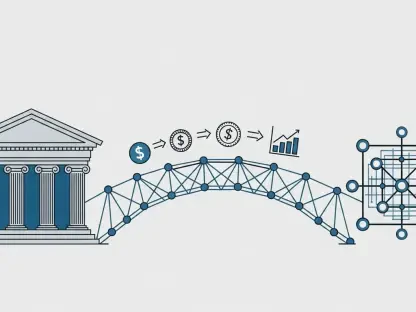Imagine a financial landscape where transactions settle almost instantly, digital currencies are as trusted as traditional money, and automated contracts execute flawlessly without intermediaries—this is the vision painted by Sasha Mills, Executive Director of Financial Market Infrastructure at the Bank of England (BoE), during a recent event. Mills emphasized how emerging technologies are reshaping the very foundation of global finance. Distributed ledger technology (DLT), smart contracts, and stablecoins are no longer experimental ideas but are becoming vital components of mainstream financial systems. This transformation, while promising immense efficiency and innovation, also demands a delicate balance of regulation to ensure stability. The BoE’s proactive stance signals a pivotal shift, positioning the UK as a frontrunner in adopting these advancements while safeguarding trust in money and payments.
Technological Evolution in Finance
Maturation of Core Innovations
The financial sector stands at a critical juncture as DLT and smart contracts reach a stage of maturity that allows for practical application. Mills highlighted that these technologies have moved beyond theoretical potential to being embedded in real-world processes. Financial market infrastructures (FMIs), which underpin secure payments and securities trades, are increasingly integrating DLT to streamline operations. A significant initiative by the BoE is the development of a synchronization interface within the Real-Time Gross Settlement (RTGS) Future Roadmap. This tool aims to enable seamless settlement of funds against assets across various ledgers, including programmable and DLT-based systems. By extending settlement hours, the interface promises to boost efficiency, ensuring that transactions are not delayed by outdated time constraints, thus paving the way for a more fluid financial ecosystem.
Enhancing Market Efficiency
Beyond the integration of DLT, the BoE is driving efficiency through systemic upgrades that complement these technologies. One notable effort is the transition to a T+1 settlement cycle, which shortens the time between trade execution and final settlement. According to Mills, this change is expected to release up to $1 billion in funds currently held as margin, significantly improving liquidity across markets. Additionally, explorations into accepting tokenized assets as collateral for central counterparties (CCPs) signal a readiness to adapt traditional systems to digital realities. Streamlined regulatory frameworks for margin models and new product authorizations further demonstrate a commitment to fostering innovation without compromising operational stability. These steps collectively aim to reduce friction in financial processes, ensuring that markets can handle the complexities of modern digital tools while maintaining robustness against potential disruptions.
Regulatory Frameworks for Emerging Assets
Building Trust in Digital Currencies
Stablecoins, a rapidly growing form of digital currency, are under intense scrutiny as their adoption in everyday payments increases. Mills revealed that the BoE is crafting a comprehensive regulatory framework for stablecoins, incorporating international standards and insights from global jurisdictions. A key proposal within this framework is the requirement for a portion of backing assets to be held in central bank deposits. This positions the BoE as a direct “banker” to stablecoin issuers, enhancing trust by reducing reliance on commercial banks, which may view these issuers as competitors. Such measures are designed to instill confidence among users, ensuring that stablecoins can serve as a reliable medium of exchange without introducing systemic risks. This regulatory approach underscores the importance of aligning innovation with consumer protection.
Balancing Innovation with Stability
The BoE’s broader regulatory strategy reflects a dual commitment to embracing technological advancements while safeguarding financial integrity. Projects like the upgraded RTGS service (RT2) and ongoing consultations on collateral types for CCPs exemplify this balance. Mills emphasized that while the opportunities presented by digital assets are significant, unchecked innovation could pose risks to market continuity. The focus remains on creating environments where new technologies can thrive without undermining systemic stability. This involves careful calibration of rules to prevent vulnerabilities while encouraging the modernization of financial systems. By aligning with global efforts to integrate digital assets into regulated spaces, the BoE aims to ensure that the benefits of innovation—such as faster transactions and reduced costs—are realized without sacrificing the trust that underpins financial markets.
Vision for a Modern Financial Ecosystem
Reflecting on Strategic Progress
Looking back, the BoE’s efforts to integrate technologies like DLT, smart contracts, and stablecoins into financial markets marked a transformative chapter. Through initiatives such as shorter settlement cycles and tokenized collateral acceptance, the bank demonstrated a forward-thinking approach. Regulatory advancements for stablecoins, grounded in international collaboration, further solidified trust in emerging forms of money. Mills’ insights during the speech underscored a nuanced balance between embracing change and protecting the financial ecosystem, ensuring that innovation did not outpace safety measures. These steps collectively positioned the UK as a leader in navigating the complexities of digital finance.
Charting the Path Ahead
Moving forward, the focus should center on refining these frameworks to address evolving challenges in the digital finance landscape. Collaboration between regulators, industry stakeholders, and technology developers will be crucial to anticipate risks and harness opportunities. Prioritizing scalable solutions for DLT integration and stablecoin oversight can further enhance market resilience. As financial systems continue to adapt, ongoing dialogue and adaptive policies will ensure that technological progress strengthens rather than destabilizes global markets. The journey ahead demands vigilance and creativity to maintain a competitive edge in an increasingly digital world.









